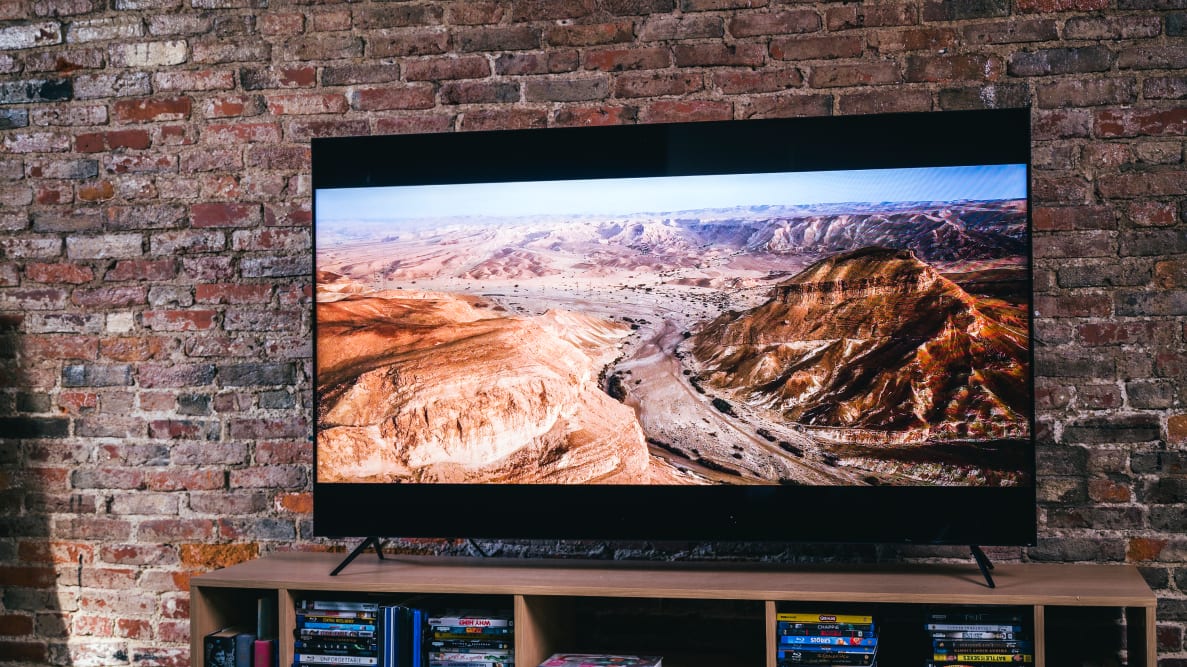Pros
-
Excellent contrast and color
-
HDMI 2.1 support
Cons
-
Ho-hum design
-
Frustrating smart platform
But it's not just the P-Series Quantum X's picture-quality-to-price-tag ratio that makes it a good choice; it's also packed to the gills with future-facing features that make it the perfect centerpiece for a new home theater. It supports Dolby Vision, various HDMI 2.1 gaming-centric features, and eARC for high-resolution audio pass through.
The only downsides are its ho-hum design and its lackluster smart platform, but the latter can be addressed with the purchase of an external streaming device. Simply put, the Vizio P-Series Quantum X is an excellent top-shelf TV that manages to cost less than just about everything else on its shelf—and it does so without sacrificing performance.
Editor's note: Due to COVID-19 complications, this review leans heavily on test results in lieu of hands-on time with the TV.
About the Vizio P-Series Quantum X
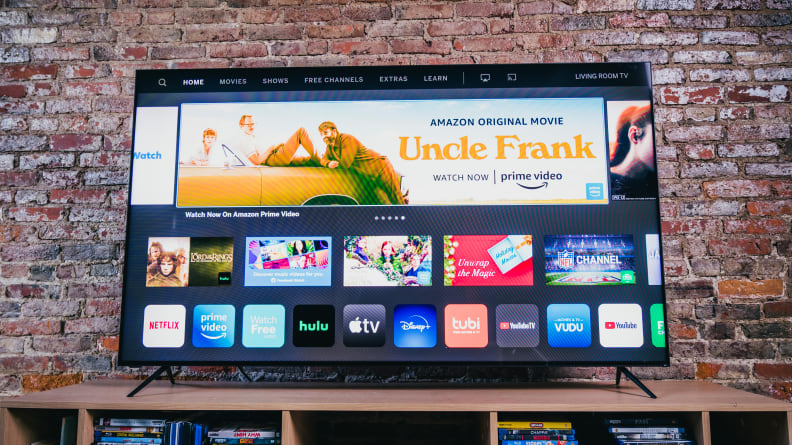
The Vizio P-Series Quantum X is available in three sizes: 65 inches, 75 inches, and 85 inches.
The Vizio P-Series Quantum X—or "PQX" for short—is available in just three sizes: 65 inches, 75 inches, and 85 inches. We tested the 65-inch version, which we received on loan. Here's how each of the sizes in the series shake out in terms of pricing:
- 65-inch (Vizio P65QX-H1), MSRP $1,529.99 (384 local dimming zones)
- 75-inch (Vizio P75QX-H1), MSRP $1,999.99 (480 local dimming zones)
- 85-inch (Vizio P85QX-H1), MSRP $3,099.99 (792 local dimming zones)
Different sizes of TVs in a series tend to perform very similarly to one another, so we don't expect there to be major differences between the 65-, 75-, and 85-inch variants of the P-Series Quantum X. One thing to keep in mind, however, is the difference in local dimming zone count. Generally speaking, more local dimming zones are favorable, as they allow for tighter contrast control. When it comes to the PQX, the zone count increases as you move up in screen size, so the 85-inch PQX may perform slightly better when it comes to contrast control.
Here's a rundown of key specifications shared by all sizes in the series:
- Resolution: 4K (3,840 x 2,160)
- Display type: VA LED with quantum dots
- Local dimming: Full-array local dimming
- HDR support: HDR10, HDR10+, HLG, Dolby Vision
- Dolby Atmos: Yes
- eARC support: Yes
- Native refresh rate: 120 Hz
- Smart platform: Yes (Vizio SmartCast)
- Color: DCI-P3/10-bit color space
- Processor: IQ Ultra
- Variable Refresh Rate (VRR): Yes (AMD FreeSync, 48 Hz - 120 Hz)
- Auto Low Latency Mode (ALLM): Yes
- Other features: Google Assistant, Alexa, Apple AirPlay, and Chromecast integration
The PQX offers Google Assistant and Alexa integration. In addition, Vizio's built-in smart platform, SmartCast, features Chromecast and Apple AirPlay functionality. The P-Series Quantum X also supports Variable Refresh Rate (VRR) and Auto Low Latency Mode (ALLM) right out of the box.
The included remote control is slightly different than Vizio remotes of years past, but if you've used a Vizio remote in the last few years, you'll be plenty familiar with Vizio's clicker this year.
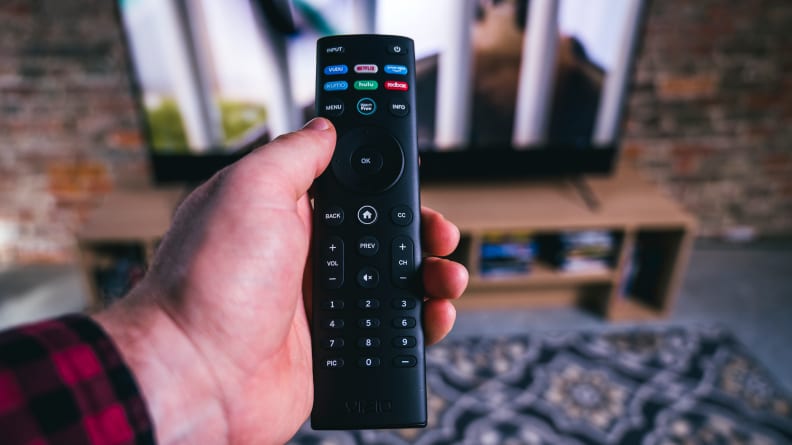
Vizio's remote control has gotten a bit of a facelift, but its dimensions and basic functionality remain the same.
Performance Data
Before testing each TV, we make sure the panel is on and receiving a continuous signal for at least 24 hours, allowing the pixels plenty of time to warm up. Our 65-inch P-Series Quantum X received this standard warm-up time before any readings were taken.
For SDR tests, we used Vizio's "Calibrated" picture setting. For HDR tests, we used the TV's "Calibrated HDR10" picture setting. We’ve chosen these settings because of their accuracy, but results may vary depending on which picture mode is enabled.
We use a standard ANSI checkerboard pattern for most of our basic contrast tests—including the ones reported below—but we also use white and black windows ranging from 2% to 90% to test how well the contrast holds up while displaying varying degrees of brightness.
I'll expand on our test results throughout the review, but for now, here are some key takeaways:
• HDR contrast (brightness/black level): 815.6 nits/0.059 nits (ANSI checkerboard) • SDR contrast (brightness/black level): 485.5 nits/0.035 nits (ANSI checkerboard) • HDR peak brightness: 1,785 nits (20% white window) • HDR color gamut coverage: 95% (DCI-P3/10-bit) • SDR color gamut coverage: 92% (Rec.709)
Connectivity
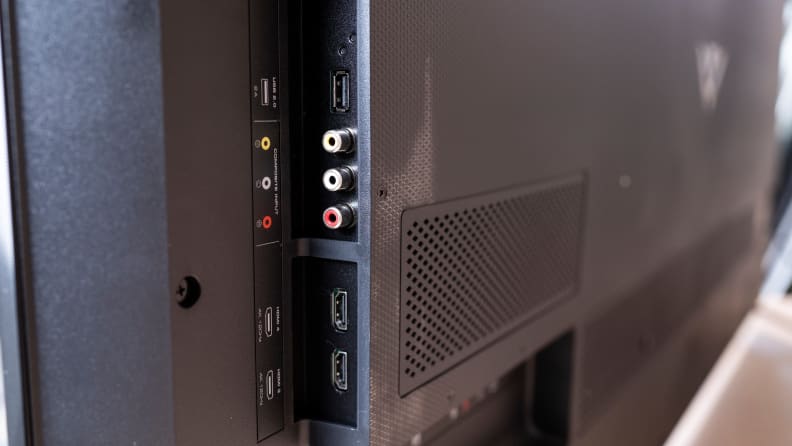
The Vizio P-Series Quantum X is equipped with four HDMI 2.1 ports.
The Vizio P-Series Quantum X is equipped with HDMI 2.1 ports and therefore supports HDMI 2.1-adjacent features such as VRR, ALLM, and 4K gaming at 120 FPS. These next-generation features are great to have in your back pocket if you own (or plan on owning) an Xbox Series X or a Playstation 5 gaming console.
On the back of the PQX's panel you'll find a cutout that houses the following inputs:
• 4x HDMI 2.1 (1x eARC) • 1x USB 2.0 • LAN ethernet port, RF input, optical audio output, analog audio output
What We Like
Incredible brightness, contrast, and color
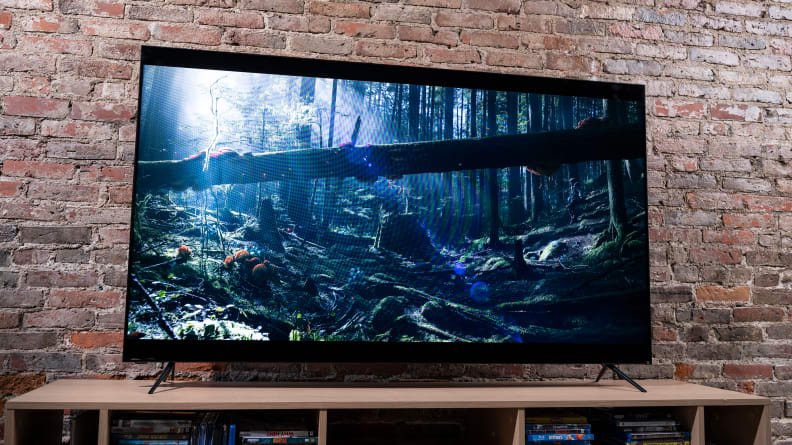
The Vizio P-Series Quantum X is among the brightest TVs we've ever tested.
From top to bottom, the Vizio P-Series Quantum X is engineered to deliver eye-popping contrast. The word "quantum" in the series' name refers to the TV's inclusion of quantum dots, microscopic dots embedded in the panel that produce richer colors and a brighter overall picture. And when I say that the P-Series Quantum X is bright, I mean it's really, really bright. In our lab tests, the PQX routinely climbed as high as 1,500 to 2,000 nits during HDR content, which means it's not only the brightest TV we've tested of late, but one of the brightest TVs we've ever seen, period. It even outpaces Samsung's stunning Q90T QLED when it comes to delivering consistent, dazzling highlights.
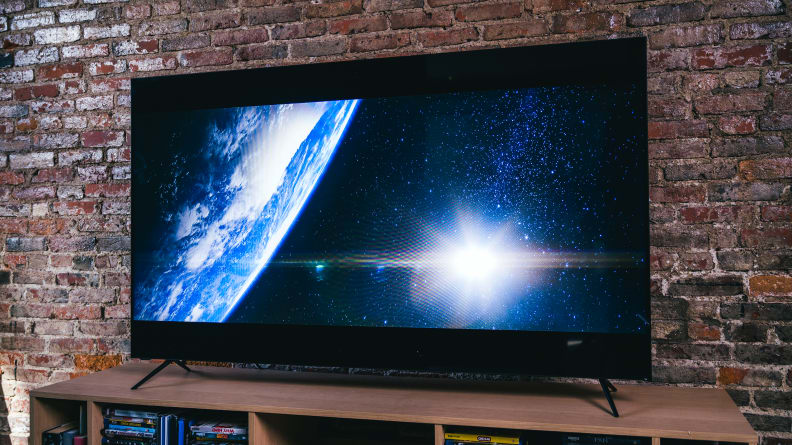
The PQX's full-array panel and local dimming software do a great job limiting light bloom.
The PQX's VA-style LED display is outfitted with hundreds of individual local dimming zones that minimize light bloom whenever bright and dark picture elements clash. This hardware—combined with excellent local dimming software—makes for impressively deep black levels. In SDR and HDR, the PQX's black levels sit between 0.035 and 0.065 nits on average—no where near the perfect black levels of an OLED TV, significantly better than what we recently measured on the Samsung Q90T.
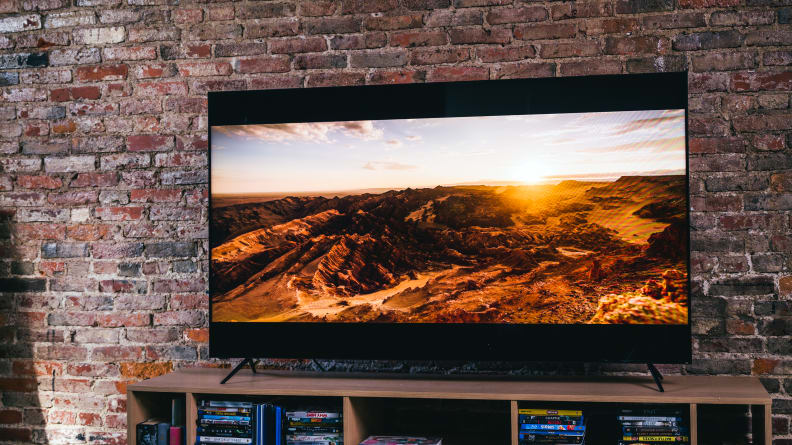
Thanks to the TV's quantum dots, colors look extra rich on the PQX, particularly during HDR content.
The PQX's quantum dots also play a role in the TV's sensational color reproduction, where about 95% of the extra-wide DCI-P3 color gamut is represented. Colors on this TV look gorgeous no matter what, but you'll really get a sense of what the PQX's hardware is capable of during 4K/HDR content.
Future-facing features for gamers and cinephiles
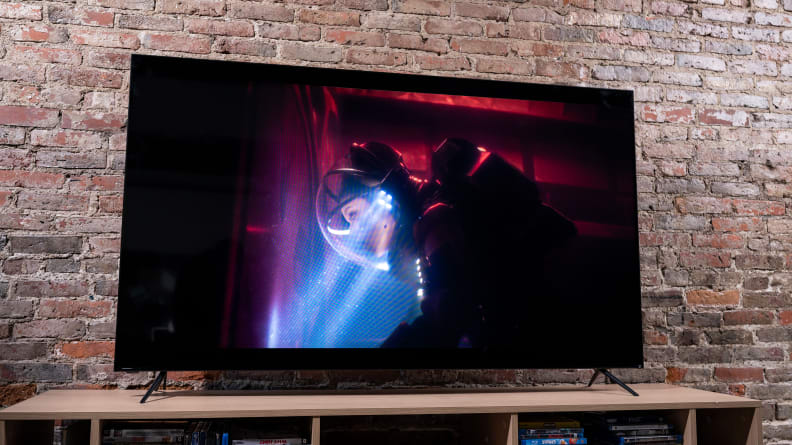
With HDMI 2.1 and eARC support in tow, the PQX is a great TV for gamers and A/V enthusiasts looking to build an impressive home theater.
The PQX arrives at an crossroads for prospective TV buyers: You can either splash out on a TV whose fancy features will flourish in the future, or save some money on a TV whose hardware will begin to lag behind in a few years. In general, we're of the mindset that if you're going to pay a premium price for a posh purchase, you should probably make that investment last as long as possible. A TV like the P-Series Quantum X is a not-so-modest financial undertaking for most folks, so we're thrilled that Vizio made sure it's one that'll stand the test of time.
The PQX arrives with four HDMI 2.1 ports, and naturally, it supports an array of features that the new HDMI format will slowly standardize over the next decade. These features include Variable Refresh Rate (a gaming enhancement that prevents visual artifacts and screen tearing), Auto Low Latency Mode (which automatically enables low latency when a console is detected), and support for 4K gaming at 120 Hz. If you currently own (or plan to own) the PlayStation 5 or the Xbox Series X and you want to get the most out of them during their lifetime, these are the add-ons that matter.
The P-Series Quantum X also features eARC support via HDMI, which means it's capable of passing high-resolution audio to sound systems that support it. If you're integrating Dolby Atmos into your home theater, the PQX will allow you to pass Dolby TrueHD information to a soundbar or sound system via HDMI.
Gamers, sports fans, and A/V enthusiasts will also be pleased with the PQX's native refresh rate of 120 Hz, which allows for mostly judder-free motion across all content types. As with most TVs, the motion interpolation software can be aggressive depending on the chosen settings, but the TV's motion handling is superb even with its enhancements disabled.
What We Don't Like
A smart platform that struggles to compete

The Vizio P-Series Quantum X is available in three sizes: 65 inches, 75 inches, and 85 inches.
While Vizio's smart platform has seen improved stability in recent years, it remains one of the weaker smart platforms available—even without most of the bugs that used to plague the software in years past. SmartCast, as it's called, is essentially just a handful of pre-installed apps and extra features held together by a basic (albeit easy-to-navigate) user interface. While the heavy-hitters (Netflix, Hulu, YouTube, Disney+, and Prime Video) are mostly accounted for, there's no way for users to add to their app library, so you're basically stuck with what Vizio offers out of the box or in future updates.
It's always nice to have features like Chromecast, Apple AirPlay, and Alexa support in your back pocket, but these features don't deliver content as quickly and easily as Roku's Channel Store or Android TV's Google Play store. Without a library of apps to curate your experience, all you can do is micromanage the pre-installed apps and cast to the TV with your own devices.
Somewhat outdated design
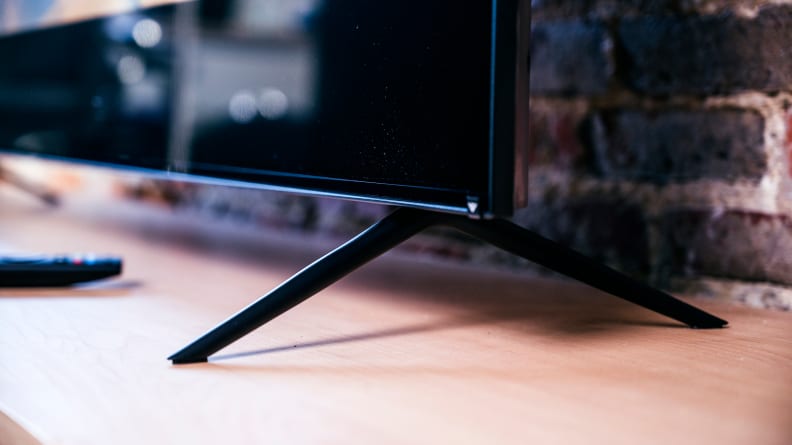
All three sizes of the PQX feature the same design: a large panel that rests atop two wide-set, angular feet.
Fans of a minimalist approach to TV design will likely appreciate the PQX's non-fussy look, but if you've passed on Vizio LED TVs in recent years due to their meat-and-potatoes design philosophy, you'll probably have a blasé reaction to the P-Series Quantum X.
Every size in the series features the wide-set, boomerang-shaped feet we've come to expect from Vizio's mid-range and high-end TV lineups in recent years, with metallic accents similar to what we saw on the 2019 Vizio P-Series Quantum X. In fact, there's very few differences between the design of this iteration of the PQX and that of its predecessor.

The bezels are quite narrow.
Fortunately, like its predecessor, the PQX's bezels are narrow enough to keep the picture from getting squeezed and the overall build feels sturdy. It's certain to blend into most living rooms, but folks who want a high-end TV that wears its luxury on its sleeve might find the PQX's design underwhelming.
Should You Buy It?
Yes—this is one of the best TVs you can buy right now.
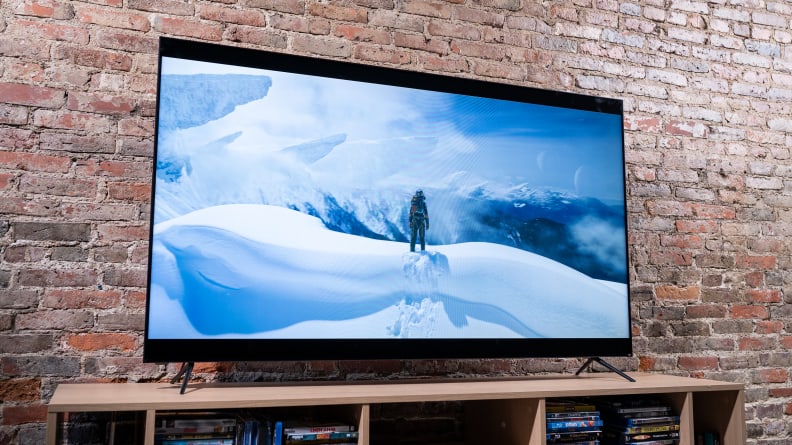
The Vizio P-Series Quantum X is an excellent top-shelf TV that manages to cost less than just about everything else on its shelf.
The Vizio P-Series Quantum X is a fantastic TV from purely a performance standpoint, but its array of future-facing features makes it one of the best top-shelf TVs you can invest in right now. Its fiercest competitors—the Samsung Q90T and the LG CX—offer a similar selection of features and tremendous performance, too, but neither of them get as bright.
If you're shopping for a TV that'll support next-generation gaming features and you're prioritizing overall picture quality above all else, you ought to take a look at the LG CX, our current top-rated TV. It doesn't come close to the PQX's average brightness, but its perfect black levels, eye-catching design, and HDMI 2.1 support might be enough to sway you. The CX is pricier than the PQX, but its performance justifies the cost.
If quantum dots and sizzling brightness are a must, the Samsung Q90T offers HDMI 2.1, comparable contrast, and a better built-in smart platform, but its price tag is much higher than that of the PQX, and the difference in cost probably isn't worth it unless you very much value Samsung's software and iconic design.
Given the state of the market, the P-Series Quantum X is the among best deals you can get on a TV with top-shelf performance. If its ho-hum design and disappointing smart platform don't make a difference to you, it'll be a terrific investment for years to come.
Meet the testers
Michael Desjardin graduated from Emerson College after having studied media production and screenwriting. He specializes in tech for Reviewed, but also loves film criticism, weird ambient music, cooking, and food in general.
Julia is the Senior Scientist at Reviewed, which means that she oversees (and continually updates) the testing of products in Reviewed's core categories such as televisions, washing machines, refrigerators, and more. She also determines the testing methods and standards for Reviewed's "The Best Right Now" articles.
Checking our work.
Our team is here to help you buy the best stuff and love what you own. Our writers, editors, and experts obsess over the products we cover to make sure you're confident and satisfied. Have a different opinion about something we recommend? Email us and we'll compare notes.
Shoot us an email
